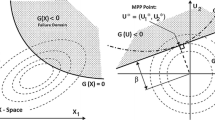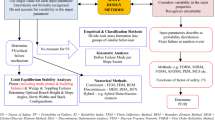Abstract
Stability analysis of rock slopes is a complex problem because of uncertainties involved in the rock mass properties. The probabilistic approach is a rational way to deal with these uncertainties. This article investigates the stability of a rock slope by deterministic and probabilistic approaches by considering uncertainty in peak and residual strength parameters and strength-drop in stress-strain behavior of the rock mass. A Geological Strength Index (GSI) based on a quantitative approach was used to estimate the statistical parameters of peak and residual strength parameters. Reliability index of the slope was then estimated using Hong’s Point Estimate Method coupled with the finite element method. The approach is demonstrated using an important case study of a Himalayan rock slope supporting the piers of the world’s highest railway bridge. It was observed that the factor of safety and reliability index for the slope was highly sensitive to residual strength parameters, and; hence, ignoring strength-drop from the rock mass behavior and uncertainty in residual strength parameters can overestimate the factor of safety and the reliability index of rock slopes. A parametric study is carried out to evaluate the influence of the coefficient of variation of uniaxial compressive strength of intact rock, the Hoek-Brown strength parameter of intact rock, roughness and alteration parameters of the joints on the probability of failure and the reliability index. The approach is verified by comparing the estimated displacements along the slope with in-situ measured displacements observed during field monitoring over the years. The approach used can be extended to the rock slopes or rock slides where high displacements in the slopes are expected due to triggering forces like seismic forces, excavation or structural loads.















Similar content being viewed by others
References
Ahmadabadi M, Poisel R (2015) Assessment of the application of point estimate methods in the probabilistic stability analysis of slopes. Comput Geotech 69:540–550
Arzua J, Alejano LR (2013) Dilation in granite during servo-controlled triaxial strength tests. Int J Rock Mech Min Sci 61:43–56
Arzua J, Alejano LR, Walton G (2014) Strength and dilation of jointed granite specimens in servo-controlled triaxial tests. Int J Rock Mech Min Sci 69:93–104
Babu GLS, Murthy DSN (2005) Reliability analysis of unsaturated soil slopes. J Geotech Geoenviron Eng 131(11):1423–1428
Barton NR, Bandis SC, Bakhtar K (1985) Strength, deformation and conductivity coupling of joints. Int J Rock Mech Min Sci Geomech Abstr 22(3):121–140
Buzzi O, Sieffert Y, Mendes J (2014) Strength of an Australian coal under low confinement. Rock Mech Rock Eng 47:2265–2270
Cai M (2011) Rock mass characterization and rock property variability considerations for tunnel and cavern design. Rock Mech Rock Eng 44:379–399
Cai M, Kaiser PK, Uno H, Tasaka Y, Minami M (2004) Estimation of rock mass strength and deformation modulus of jointed hard rock masses using the GSI system. Int J Rock Mech Min Sci 41(1):3–19
Cai M, Kaiser PK, Tasaka Y, Minami M (2007) Determination of residual strength parameters of jointed rock masses using the GSI system. Int J Rock Mech Min Sci 44(2):247–265
Chowdhury R, Flentje P (2003) Role of slope reliability analysis in landslide risk management. Bull Eng Geol Environ 62:41–46
Crowder JJ, Bawden WF (2004) Review of post-peak parameters and behaviour of rock masses: current trends and research. RocNews 2004, Fall: 13
Cruden DM, Martin CD (2007) Before the frank slide. Can Geotech J 44:765–780
Dai SH, Wang MO (1992) Reliability analysis in engineering applications. Van Nostrand Reinhold, New York
Duzgun HSB, Bhasin RK (2009) Probabilistic stability evaluation of Oppstadhornet rock slope, Norway. Rock Mech Rock Eng 42:729–749
Duzgun HSB, Yucemen MS, Karpuz C (2003) A methodology for reliability-based design of rock slopes. Rock Mech Rock Eng 36(2):95–120
Eberhardt E, Stead D, Coggan JS (2004) Numerical analysis of initiation and progressive failure in natural rock slopes-the 1991 Randa rockslide. Int J Rock Mech Min Sci 41:69–87
Edelbro C (2003) Rock mass strength - a review. Technical report. Department of Civil and Mining Engineering, Division of Rock Mechanics. Luleå University of Technology 16 ISSN: 1402–1536
Gao FQ, Kang HP (2016) Effects of pre-existing discontinuities on the residual strength of rock mass- insight from a discrete element method simulation. J Struct Geol 85:40–50
Hamby DM (1994) A review of techniques for parameter sensitivity analysis of environmental models. Environ Monit Assess 32(2):135–154
Hammah R, Yacoub T, Corkum B, Curran J (2005) A comparison of finite element slope stability analysis with conventional limit-equilibrium investigation. In: Proceedings of the 58th Canadian Geotechnical and 6th Joint IAH-CNC and CGS Groundwater Specialty Conferences – GeoSask 2005, Saskatoon, Canada, p 480–487
Hoek E, Brown ET (1997) Practical estimates of rock mass strength. Int J Rock Mech Min Sci 34(8):1165–1186
Hoek E, Diederichs MS (2006) Empirical estimation of rock mass modulus. Int J Rock Mech Min Sci 43:203–215
Hoek E, Carranza-Torres C, Corkum B (2002) Hoek–Brown failure criterion—2002 edition. In: Proceedings of the 5th North American rock mechanics symposium, Toronto, Canada, p 267–273
Hong HP (1998) An efficient point estimate method for probabilistic analysis. Reliab Eng Syst Saf 59:261–267
Hudson JA, Brown ET, Fairhurst C (1971) Optimizing the control of rock failure in servo-controlled laboratory tests. Rock Mech 3:217–224
Idris MA, Saiang D, Nordlund E (2015) Stochastic assessment of pillar stability at Laisvall mine using artificial neural network. Tunn Undergr Space Technol 49:307–319
ISRM (1981) Rock characterizition, testing and monitoring. Pergamon Press, NewYork
Italfer FS-SIS.TAV (1996) Linee guida per la progettazione esecutiva delle gallerie naturali. Roma
Kulatilake PHSW, Liang J, Gao H (2001) Experimental and numerical simulations of jointed rock block strength under uniaxial loading. J Eng Mech 127(12):1240–1247
Langford CJ (2013) Application of reliability methods to the design of underground structures. PhD thesis, Queen’s University, Ontario, Canada
Langford JC, Diederichs MS (2013) Reliability based approach to tunnel lining design using a modified point estimate method. Int J Rock Mech Min Sci 60:263–276
Latha GM, Garaga A (2010) Seismic stability analysis of a Himalayan rock slope. Rock Mech Rock Eng 43:831–843
Li AJ, Cassidy MJ, Wang Y, Merifield RS, Lyamin AV (2012) Parametric Monte Carlo studies of rock slopes based on the Hoek–Brown failure criterion. Comput Geotech 45:11–18
Maio CD, Scaringi G, Vassallo R (2015) Residual strength and creep behaviour on the slip surface of specimens of a landslide in marine origin clay shales: influence of pore fluid composition. Landslides 12:657–667
Marinos P, Hoek E (2000) GSI: a geologically friendly tool for rock mass strength estimation. In: Proceedings of the GeoEng2000 at the International Conference on Geotechnical and Geological Engineering, Melbourne, Australia, p 1422–1446
Pain A, Kanungo DP, Sarkar S (2014) Rock slope stability assessment using finite element based modelling–examples from the Indian Himalayas. Geomech Geoeng 00:1–16
Pal S, Kaynia AM, Bhasin RK, Paul DK (2012) Earthquake stability analysis of rock slopes: a case study. Rock Mech Rock Eng 45:205–215
Palisade Co (2015) @RISK. Palisade Corporation, v.7.5
Pan XD, Grasso PG, Mahtab MA, Reed MB (1991) Application of updated Hoek-Brown criterion to predict the loosened zone around a tunnel. In: Proceedings of mechanical tests on pervasively jointed rock material. Computer methods and advances in geomechanics, Balkema, Rotterdam, pp 1491–1496
Reik G, Zacas M (1978) Strength and deformation characteristics of jointed media in true triaxial compression. Int J Rock Mech Min Sci Geomech Abstr 15:295–303
Ribacchi R (2000) Mechanical tests on pervasively jointed rock material: insight into rock mass behaviour. Rock Mech Rock Eng 33(4):243–266
Rocscience (2014) Phase2 version 8.020, Finite Element Analysis for excavations and slopes. Rocscience Inc.31 Balsam Ave., Toronto, Ontario M4E 1B2, Canada
Rummel F, Fairhurst C (1970) Determination of the post-failure behavior of brittle rock using a servo-controlled testing machine. Rock Mech 2:189–204
Russo G, Kalamaras GS, Grasso P (1998) A discussion on the concepts of geomechanical classes behavior categories and technical classes for an underground project. Gallerie e Grandi Opere Sotterranee 54:40–51
Santarelli FJ, Brown ET (1989) Failure of three sedimentary rocks in triaxial and hollow cylinder compression tests. Int J Rock Mech Min Sci Geomech Abstr 26(5):401–413
Sjoberg J (1997) Estimating rock mass strength using the Hoek–Brown failure criterion and rock mass classification—a review and application to the Aznalcollar open pit. Division of Rock Mechanics, Department of Civil and Mining Engineering, Lulea University of Technology, Sweden
Skempton AW (1964) Fourth Rankine lecture: long-term stability of clay slopes. Geotechnique 14(2):77–101
Skempton AW (1985) Residual strength of clays in landslides, folded strata and the laboratory. Geotechnique 35(1):3–18
Sonmez H, Ulusay R (1999) Modifications to the geological strength index (GSI) and their applicability to the stability of slopes. Int J Rock Mech Min Sci 36:743–760
Srivastava A, Babu GLS, Haldar S (2010) Influence of spatial variability of permeability property on steady state seepage flow and slope stability analysis. Eng Geol 110(3–4):93–101
Tiwari G, Latha GM (2016) Design of rock slope reinforcement: an Himalayan case study. Rock Mech Rock Eng 49(6):2075–2097
Tiwari RP, Rao KS (2004) Physical modeling of a rock mass under a true triaxial stress state. Int J Rock Mech Min Sci 41(3):1–6
Tiwari RP, Rao KS (2006a) Post failure behaviour of a rock mass under the influence of triaxial and true triaxial confinement. Eng Geol 84:112–129
Tiwari RP, Rao KS (2006b) Deformability characteristics of a rock mass under true-triaxial stress compression. Geotech Geol Eng 24:1039–1063
Tutluoglu L, Ibrahim FO, Karpuz C (2015) Relationship between pre-failure and post-failure mechanical properties of rock material of different origin. Rock Mech Rock Eng 48:121–141
U.S. Army Corps of Engineers (1999) Risk-based analysis in geotechnical engineering for support of planning studies, engineering and design. Dept. of Army, Washington, D.C
Ulusay R, Türeli K, Ider MH (1994) Prediction of engineering properties of a selected litharenite sandstone from its petrographic characteristics using correlation and multivariate statistical techniques. Eng Geol 37:135–157
Walton G, Arzua J, Alejano LR, Diederichs MS (2015) A laboratory-testing based study on the strength, deformability, and dilatancy of carbonate rocks at low confinement. Rock Mech Rock Eng 48:941–958
Wang G, Zhang X, Jiang Y, Wu X, Wang S (2016) Rate-dependent mechanical behavior of rough rock joints. Int J Rock Mech Min Sci 83:231–240
Wawersik WR, Brace WF (1971) Post-failure behavior of a granite and diabase. Rock Mech 3:61–85
Wawersik WR, Fairhurst C (1970) A study of brittle rock fracture in laboratory compression experiments. Int J Rock Mech Min Sci 7:561–575
Wen BP, Jiang XZ (2017) Effect of gravel content on creep behavior of clayey soil at residual state: implication for its role in slow-moving landslides. Landslides 14:559–576
Wu C, Hao H, Zhou Y (2000) Statistical properties of the Bukit Timah granite in Singapore. J Test Eval 28(1):36–43
Wyllie DC, Mah WC (2004) Rock slope engineering. Spon Press, New York
Yang ZY, Chen JM, Huang TH (1998) Effect of joint sets on the strength and deformation of rock mass models. Int J Rock Mech Min Sci 35:75–84
Yang SQ, Jing HW, Wang SY (2012) Experimental investigation on the strength, deformability, failure behavior and acoustic emission locations of red sandstone under triaxial compression. Rock Mech Rock Eng 45(4):583–606
Author information
Authors and Affiliations
Corresponding author
Appendix
Appendix
A comparison between shear strength parameters estimated using the current approach and in-situ direct shear tests is provided for different types and qualities of rock masses. A total of nine case studies is included.
Rights and permissions
About this article
Cite this article
Tiwari, G., Latha, G.M. Reliability analysis of jointed rock slope considering uncertainty in peak and residual strength parameters. Bull Eng Geol Environ 78, 913–930 (2019). https://doi.org/10.1007/s10064-017-1141-1
Received:
Accepted:
Published:
Issue Date:
DOI: https://doi.org/10.1007/s10064-017-1141-1




